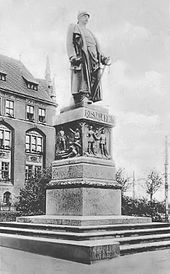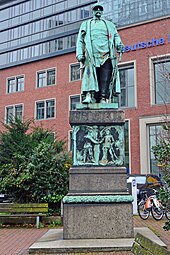Bismarck Monument (Essen)

The Bismarck monument on the south side of the square of the same name in Essen's southern district is one of numerous Bismarck monuments that were erected in the Kingdom of Prussia and the German Empire since 1868 .
Monument and history
The statue , which consists of a 1.2 meter high base and a two meter bronze statue and a total of 3.2 meters high, was created by Reinhold Felderhoff between 1894 and 1899 and unveiled on September 23, 1899 on Bismarckplatz, which was named around 1887.
The bronze statue depicts the Reich Chancellor Otto von Bismarck with a military skirt, saber and spiked bonnet. It is on a base made of Kosseine granite , on which there are bronze, heroic depictions of history relating to the city of Essen. The industrialist Alfred Krupp took over the financing of the entire monument . In 1879, Bismarck was the first to receive the honorary citizenship of Essen, as he was considered the protector of the Krupp steel industry and mining.
The monument was erected on Bismarckplatz in front of the main entrance of the former Royal Railway Directorate in Essen , also to emphasize its importance. Except for a few bullet holes, it survived the Second World War . The monument was dismantled during the extensive construction work for the construction of the Ruhrschnellweg tunnel and the subway construction in the area. It was stored from February 1, 1968 to October 19, 1970.
On December 9, 1993, the Bismarck monument was included in the list of monuments of the city of Essen.
Individual representations
On the edges of the bronze reliefs, which are attached to the four sides of the base, oak trunks are shown, which connect the individual representations through their branches.
The wings of the imperial eagle lie in the front, northern relief above two German soldiers, a Bavarian and a Prussian, who seal the German unification after the victory over France with a handshake under oak trees .
In the western portrait, the industrialist Alfred Krupp Otto von Bismarck shows his guns. Reference is made here to Bismarck's visit to Essen on October 28, 1864, when he was returning to Germany from Biarritz . The then Prussian Prime Minister Otto von Bismarck had accepted Krupp's invitation and visited the cast steel factory .
The southern bronze relief of the base shows Germania holding her arms protectively over the Krupp smithy, which manufactured the weapons for the German Wars of Unification in the Krupp cast steel factory in what was then known as the cannon town of Essen . These include the German-Danish War in 1864 , the German War in 1866 and the German-French War in 1870/71 .
The eastern bronze portrait shows King Wilhelm I of Prussia standing on the steps of a throne . Above him an eagle flies towards the sun, next to which in ancient script the words Nec soli cedit (he does not give way to the sun). On the right is von Bismarck and proclaims the Kaiser to be the German ruler - "His Majesty the Kaiser live high!". Wilhelm I takes off his spiked hat when he receives the imperial crown from a genius .
- Individual representations of the monument
Two German soldiers seal German unification with a handshake under oak trees .
Alfred Krupp shows Otto von Bismarck his guns.
Germania holds her arms protectively over the Krupp forge.
Monument restoration 2020
At the beginning of 2020, the monument will be restored within around two months. The surfaces of the bronze sculpture and the relief plates in the base were cleaned while maintaining the green patina and the joints between the stone base and the bronze sculpture were repaired. In addition, the statics were checked and the interior of the sculpture was examined endoscopically.
Web links
Individual evidence
- ^ A b T. Kellen: The industrial city of Essen in words and pictures. History and description of the city of Essen. At the same time a guide through food and the surrounding area. Fredebeul & Koenen, Essen 1902.
- ↑ Unveiling of the Bismarck monument on the square in front of the railway management. ; In: Essener Volks-Zeitung of September 26, 1899
- ^ Erwin Dickhoff: Essener streets . Ed .: City of Essen - Historical Association for City and Monastery of Essen. Klartext-Verlag, Essen 2015, ISBN 978-3-8375-1231-1 .
- ^ Max Erhardt-Apolda: Bismarck in the national and international memorial . Thuringian Publishing House, Eisenach / Leipzig 1903.
- ↑ a b c Gerd Niewerth: Bronze-Bismarck fit for the next 40 years ; In: Westdeutsche Allgemeine Zeitung of February 22, 2020
- ↑ Route of industrial culture: Railway headquarters in Essen ; accessed on February 22, 2020
- ↑ Excerpt from the list of monuments of the city of Essen ; accessed on February 22, 2020
Coordinates: 51 ° 26 ′ 56 ″ N , 7 ° 0 ′ 25 ″ E




